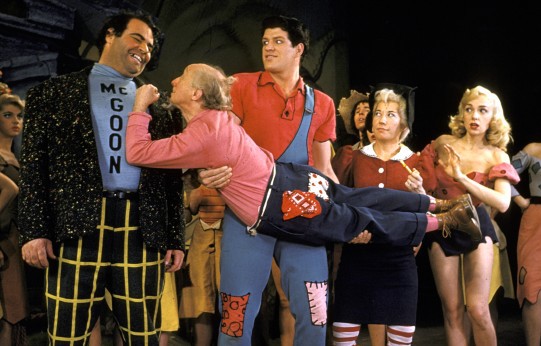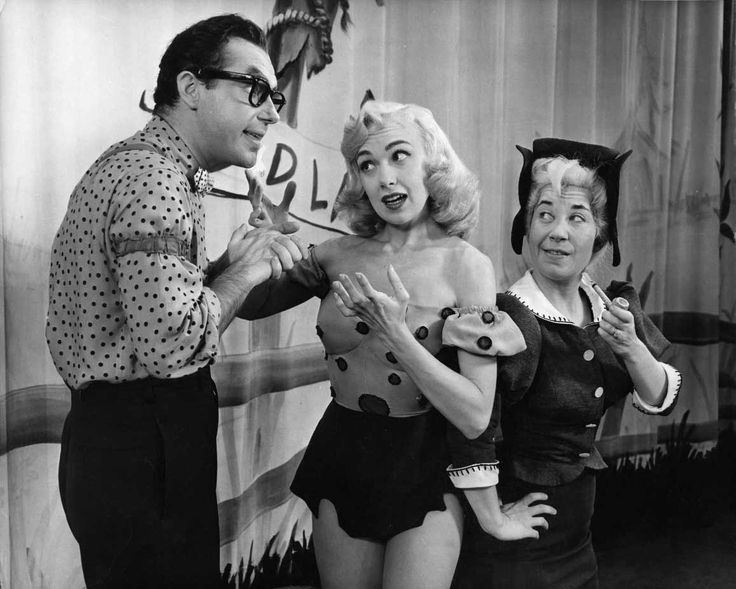Broadway Musical Time Machine: Looking Back at L’il Abner
A musical that we do not see many productions of these days, but one that is thoroughly delightful in both its satire and its memorable score, is the 1956 also-ran L’il Abner. At one point, L’il Abner was an extremely popular musical in high schools and community theatres. It was based on the popular Al Capp comic strip of the same name about a town full of colorful hillbillies, poking fun at the government, current events, and Hollywood news items. With a score by Johnny Mercer (lyrics) and Gene de Paul (music), and a book by Norman Panama and Melvin Frank, the musical riotously captured the cartoonish tone of Capp’s strip
The musical is set in the fictional burg of Dogpatch, USA, a hillbilly township in the south, full of eccentric yokel locals. Dogpatch has been deemed the “most unnecessary town in America” and the denizens find out that they must evacuate so their little hamlet can become a nuclear test site (this is sounding very 1950s Cold War, isn’t it?). Among the townsfolk is Abner Yokum, a tall, handsome, dimwit who is in love with the beautiful Daisy Mae Scragg, a girl he will have to fight to get (she’s been promised to another). Abner, along with the portly nuptials officiator Marryin’ Sam, is dispatched to Washington DC to try to save the town from atomic annihilation. While they are there, a group of scientists take interest in Abner’s physical perfection and it is revealed that Mammy Yokum’s (Abner’s Mother) Yokumberry Tonic is responsible for his perfect male proportions and physical beauty and they decide to study it. The plot of L’il Abner is generally a hodge-podge of episodic lunacy, pieced together with joyously concocted songs that basically lead Abner and Daisy through a maze of complications that will eventually bring the corny couple together.
What makes L’il Abner so delightful is the fact that it never takes itself too seriously. Indeed, even the characters’ names remind us that we should never take this show too seriously. Appassionata Von Climax, Stupefyin’ Jones, Earthquake McGoon, Senator Fogbound, and General Bulmoose are some of the colorful names we pick up along the way, not to mention the town’s famous Civil War General Jubilation T. Cornpone who is celebrated in the town square for all of his mistakes that helped secure victory for the Yankees. Indeed, the musical’s big showstopper is the wacky and woeful “Jubilation T. Cornpone” that is a hilarious recounting of the General’s miscalculations and failures. It was songs like this that helped to keep the satire both carefully disguised and insolated by laughter.
The other standout point about L’Il Abner was its robust and explosive choreography by Michael Kidd. Kidd could always energize a show with an infusion of talent, and L’il Abner was the type of show he excelled at: big, bold, colorful and smacking of a rural tang. In fact, Kidd’s “Sadie Hawkin’s Day Ballet” stopped the show as the antiquated novelty where girls are permitted to invite boys to a dance (wow, this is dated) played out through his athletic storytelling.
Sadly, L’il Abner is a musical that hasn’t held up well over the six decades since it opened. It was an interesting product of its time. Much of the subject matter that was palpably relevant in the 1950s, is now just anecdotal commentary on a bygone era. It doesn’t mean, however, that its pleasures should or need to be forgotten. In fact, a recent viewing of the film version reminded me of just how melodic and witty the score is. It’s worth spending some time with, even if it is just for reasons of nostalgia.
Some interesting facts about L’il Abner:
- L’il Abner opened at Broadway’s St. James Theatre on November 15, 1956.
- The original Broadway cast included Peter Palmer, Edie Adams, Stubby Kaye, Howard St. John, Charlotte Rae, Julie Newmar, Tina Louise, Joe E. Marks, and Bern Hoffman.
- The musical won two Tony Awards: Best Featured Actress for Edie Adams, and Best Choreography for Michael Kidd.
- The musical ran for 693 performances. The musical was then made into a 1959 film that preserved most of its original casting, staging and choreography.














